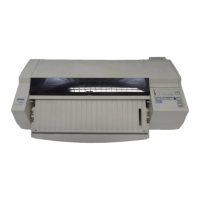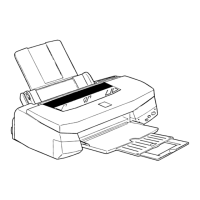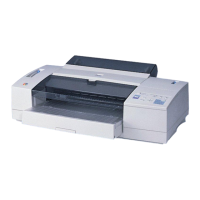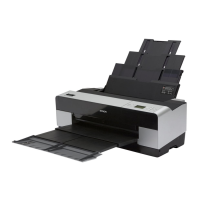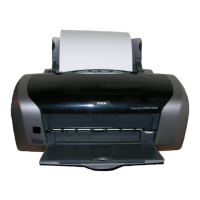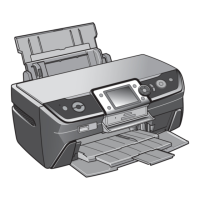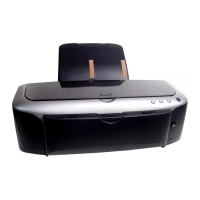EPSON Stylus COLOR 860/1160 Revision C
Operating Principles Electrical Circuit Operating Principles 48
o
Home position detection (capping position detection)
Home position is detected based on the pulses output from the linear scale
sensor and CD motor control current value. The basic home position
detection sequence is as described below:
1)The linear encoder pulse counter in the IC15 slave CPU is reset during a
power-on sequence.
2)The CR motor moves clockwise and the CR moves from left to right.
IC15 slave CPU once assumes that the CR comes in contact with the
right frame when the following conditions are satisfied:
nThe slave CPU detects the motor control current value 720mA
nP1 (= number of pulses output for the above CR movement) is 30* or
less.
* Specified value that indicates CR is movable in the home position.
(All edges in the waveform are used in this condition.)
3)The CR motor rotates counterclockwise and the CR moves from right to
left, and the IC15 slave CPU assumes that it detects the CR lock lever
position when the following conditions are satisfied:
nIC15 slave CPU detects the motor control current value 500 mA.
nDifference X between P1 and P2 (= number of pulses output while
the CR moves from the right frame) is 30 or less.
4)The CR motor rotates counterclockwise and the CR moves from left to
right again, and if IC15 slave CPU detects the motor control current
value 720 mA, it assumes that the CR comes in contact with the right
frame again.
5)Difference between P1 and P3 (= number of pulses output for the CR’s
movement from the CR lock lever to the right frame) is 4 or less.
When all conditions in the sequence are satisfied, the printer detects the CR is
in the home position.
o PTS (Print Timing Signal) production
The circuit produces PTS signal (cycle: 1/360 inches) by dividing waveform
cycles for Phase A (cycle: 1/180 inches). The print timing signal is used to
eject ink at a correct timing.
Figure 2-21. Print Timing Signal and Linear Encoder Phase A
NOTE: If the drive voltage for the CR motor reaches 800mA, a fatal error occurs.
Phase A
PTS
1/180 inches
1/360 inches

